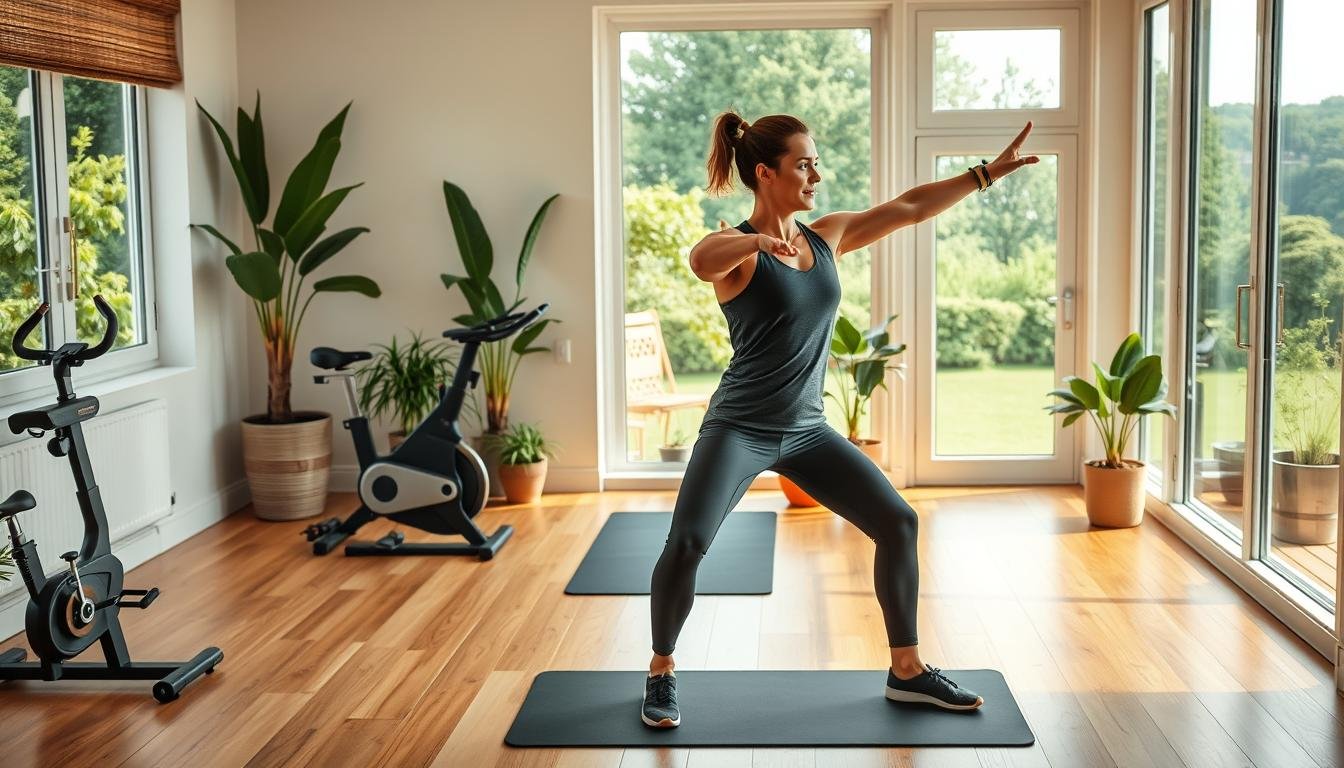Daily Workout to Boost Diabetic Health and Wellness

Living with type 2 diabetes can feel overwhelming at times. Managing blood sugar levels, staying active, and preventing complications often require constant attention. But what if there was a simple way to take control and feel better every day?
Regular exercise is one of the most effective tools for managing type 2 diabetes. It helps improve blood sugar control, reduces the risk of complications, and enhances overall well-being. The American Diabetes Association recommends at least 150 minutes of moderate-intensity activity each week to see these benefits.
This guide is here to help you understand how a consistent workout routine can make a difference. You’ll learn practical tips, safe exercises, and how to integrate physical activity into your lifestyle. Whether you’re just starting or looking to refine your routine, this article has something for you.
By the end, you’ll feel empowered to take the next step toward better diabetes management. Let’s get started!
Why Daily Exercise is Crucial for Your Diabetic Health
Staying active plays a pivotal role in controlling diabetes. Regular physical activity helps your body manage blood sugar levels more effectively. It also reduces the risk of complications like heart disease and nerve damage.

For people with type 2 diabetes, exercise can improve insulin sensitivity. This means your body uses insulin more efficiently, keeping sugar levels stable. Even small changes, like walking daily, can make a big difference.
How Regular Activity Impacts Blood Sugar Levels
When you exercise, your muscles use glucose for energy. This helps lower blood sugar levels naturally. Over time, consistent activity can improve your body’s ability to regulate insulin.
Studies show that moderate-intensity workouts, like brisk walking or cycling, are particularly effective. These activities help your body process glucose better, reducing spikes and crashes in sugar levels.
The Role of Exercise in Preventing Complications
Regular movement doesn’t just manage blood sugar—it also protects your overall health. For example, it lowers the risk of cardiovascular issues, a common concern for people with type 2 diabetes.
Exercise also improves circulation, which can prevent nerve damage. By staying active, you’re taking steps to avoid serious complications and improve your quality of life.
| Activity | Benefits |
|---|---|
| Walking | Improves insulin sensitivity, lowers blood sugar |
| Cycling | Boosts cardiovascular health, aids weight management |
| Strength Training | Builds muscle, enhances metabolism |
Boost Diabetic Health with This Daily Workout Routine
Taking charge of your fitness can transform how you manage diabetes. A well-structured exercise plan not only improves your physical condition but also helps regulate blood sugar levels effectively. The key is to set clear goals and customize your routine to meet your unique needs.

Setting Clear Goals for Success
Start by defining what you want to achieve. Whether it’s improving insulin sensitivity, building muscle, or enhancing overall health, having specific objectives keeps you focused. Assess your current fitness level to create a plan that’s realistic and achievable.
Customizing Your Routine
Not all exercises work the same for everyone. Tailor your training to suit your body and lifestyle. For example, combining strength exercises with aerobic activities can boost metabolism and improve glucose control. Start small and gradually increase intensity to avoid burnout.
Here are some tips to get started:
- Begin with low-impact activities like walking or swimming.
- Incorporate resistance training to build muscle and improve insulin sensitivity.
- Track your progress regularly to stay motivated and make adjustments as needed.
By personalizing your exercise plan, you’ll see better results and feel more confident in managing your condition. Remember, consistency is key to long-term success.
Understanding Diabetes and the Benefits of Regular Exercise
Managing diabetes effectively often starts with understanding the role of physical activity. A consistent exercise routine can help your body process glucose more efficiently, keeping blood sugar levels stable. Movement also plays a key role in improving insulin sensitivity, which is crucial for diabetes management.
When you stay active, your muscles use glucose for energy. This helps lower blood sugar levels naturally. Over time, regular movement can enhance your body’s ability to regulate insulin, reducing the risk of complications.
Improving Insulin Sensitivity Through Movement
Exercise is one of the most effective ways to improve insulin sensitivity. Studies show that aerobic activities like walking or cycling can increase your body’s response to insulin. This means your cells can use glucose more effectively, reducing spikes and crashes in blood sugar levels.
Strength training also plays a vital role. Building muscle through resistance exercises can boost metabolism and improve glucose control. Combining these activities creates a balanced fitness plan tailored to your needs.
Maintaining Weight and Balance
Keeping a healthy weight is essential for managing diabetes. Regular exercise helps burn calories and maintain muscle mass, which supports weight management. Activities that improve balance, like yoga or tai chi, can also reduce the risk of falls, especially for older adults.
Here are some simple routines to get started:
- Take a 15-minute walk after meals to regulate blood sugar.
- Incorporate strength training twice a week to build muscle.
- Practice balance exercises daily to improve stability.
| Activity | Benefits |
|---|---|
| Walking | Improves insulin sensitivity, lowers blood sugar |
| Strength Training | Builds muscle, enhances metabolism |
| Yoga | Improves balance, reduces stress |
Consistency is key to seeing long-term benefits. By sticking to your routine, you’ll not only manage diabetes better but also improve your overall well-being.
Warm-Up, Safety, and Guidelines Before You Begin
Starting your fitness journey with diabetes requires careful preparation to ensure safety and effectiveness. A proper warm-up prepares your body for physical activity, reducing the risk of injury and improving performance. It’s also essential to follow safety guidelines to protect your heart and overall well-being.
Effective Warm-Up Techniques
Warming up is crucial for getting your body ready for exercise. Begin with light movements like walking or gentle stretching. This increases blood flow to your muscles and raises your heart rate gradually. For low-intensity activities, aim for 5 to 10 minutes of warm-up. For more vigorous exercises, extend it to 10 to 15 minutes.
Incorporate dynamic stretches, such as arm circles or leg swings, to improve flexibility. These movements prepare your muscles and joints for the resistance they’ll face during your workout. Remember, a good warm-up sets the tone for a safe and effective session.
Essential Safety Tips for Starting a New Routine
Safety should always come first when beginning a new fitness plan. Monitor your blood sugar levels before, during, and after exercise. Stay hydrated throughout the day to prevent dehydration, which can affect your performance and health.
Listen to your body and avoid pushing yourself too hard. If you feel dizzy or fatigued, take a break. Gradually increase the intensity of your workouts over time to build endurance and strength safely. This approach minimizes the risk of injury and ensures long-term success.
| Warm-Up Activity | Duration | Benefits |
|---|---|---|
| Light Walking | 5-10 minutes | Increases blood flow, prepares muscles |
| Dynamic Stretching | 5-10 minutes | Improves flexibility, reduces injury risk |
| Deep Breathing | 3-5 minutes | Regulates heart rate, promotes calmness |
“A proper warm-up can decrease muscle injuries by as much as 30% to 50%. It’s a small investment of time that pays off in safety and effectiveness.”
By following these guidelines, you’ll create a solid foundation for your fitness journey. Warm up properly, stay safe, and enjoy the benefits of a healthier, more active lifestyle.
Easy Aerobic Exercises to Get You Started
Starting with simple aerobic exercises can make a big difference in managing your condition. Low-impact activities like walking, cycling, and swimming are not only accessible but also highly effective in improving cardiovascular health and regulating blood sugar levels.
These exercises are gentle on your joints while offering significant benefits for your overall well-being. Incorporating them into your routine can help reduce the risk of complications often associated with high blood sugar levels.
Walking, Cycling, and Swimming for Better Cardiovascular Health
Walking is one of the easiest ways to stay active. It requires no special equipment and can be done almost anywhere. Research shows that walking for 150 minutes per week can improve blood sugar levels, blood pressure, and cholesterol. It’s a great way to start if you’re new to physical activity.
Cycling is another excellent option. It’s low-impact and helps strengthen your heart and lungs. Whether you prefer a stationary bike or cycling outdoors, this activity can boost your cardiovascular health while keeping your blood sugar levels in check.
Swimming is perfect for those who want a full-body workout without stressing their joints. It improves endurance, flexibility, and muscle strength. Plus, it’s a fun way to stay active and manage your condition effectively.
Here are some practical tips to get started:
- Begin with short sessions, like a 10-minute walk, and gradually increase the duration.
- Monitor your blood sugar levels before and after exercise to understand how your body responds.
- Stay consistent. Even small amounts of physical activity can lead to significant improvements over time.
“Regular aerobic exercise can lower the risk of heart disease, improve insulin sensitivity, and enhance overall quality of life.”
By incorporating these easy aerobic exercises into your routine, you’ll not only manage your condition better but also enjoy a healthier, more active lifestyle. Start small, stay consistent, and watch the benefits unfold.
Strength Training and Resistance Exercises for Diabetic Health
Building muscle through resistance exercises offers powerful benefits for blood sugar control. Adding these activities to your routine can help you manage your condition more effectively while improving overall wellness. Strength training is not just about building muscle—it’s about enhancing your body’s ability to process glucose and reducing the risk of complications.
Incorporating Weightlifting and Resistance Bands
Weightlifting and resistance bands are excellent tools for improving insulin sensitivity. When you lift weights or use bands, your muscles work harder, which helps them absorb glucose more efficiently. This can lead to more stable sugar levels and better overall control.
Start with light weights or bands if you’re new to strength training. Gradually increase the intensity as your body adapts. Aim for at least two sessions per week to see significant improvements in your activity levels and metabolic health.
Building Muscle to Boost Metabolism
Muscle mass plays a key role in regulating metabolism. The more muscle you have, the more calories your body burns at rest. This can help with weight management and improve your body’s response to insulin.
Strength training also reduces the risk of complications like heart disease and nerve damage. By building muscle, you’re not just improving your physical appearance—you’re enhancing your long-term health.
Here’s a simple guide to get started with strength training:
- Begin with bodyweight exercises like squats and push-ups.
- Incorporate resistance bands or light dumbbells for added challenge.
- Focus on proper form to avoid injury and maximize results.
| Exercise | Benefits |
|---|---|
| Weightlifting | Improves insulin sensitivity, builds muscle |
| Resistance Bands | Enhances flexibility, supports joint health |
| Bodyweight Exercises | Convenient, improves overall strength |
“Strength training can lower HbA1c levels by an average of 0.5% to 1% in diabetic patients, making it a vital part of diabetes management.”
By combining strength training with aerobic exercises, you create a balanced routine that supports your overall health. Start small, stay consistent, and enjoy the benefits of a stronger, healthier you.
Flexibility and Balance Workouts to Enhance Wellness
Improving flexibility and balance can significantly enhance your overall wellness. These exercises are not only gentle on your body but also play a crucial role in managing your condition effectively. Practices like yoga and Pilates are particularly beneficial for improving circulation, reducing stress, and regulating glucose levels.
According to the American Diabetes Association, incorporating low-impact movements into your routine can help maintain stable glucose levels and reduce the risk of complications. These exercises are also recommended for their ability to improve posture, coordination, and overall quality of life.
Yoga, Pilates, and Other Low-Impact Movements
Yoga and Pilates are excellent choices for enhancing flexibility and balance. These practices focus on controlled movements and deep breathing, which can help reduce stress and improve insulin sensitivity. Studies show that regular participation in these activities can lead to better glucose management and overall well-being.
Here are some key benefits of these exercises:
- Improved circulation and glucose regulation.
- Enhanced flexibility and muscle strength.
- Reduced stress and anxiety levels.
Incorporating these activities into your weekly routine can provide sustained benefits. Start with short sessions and gradually increase the duration as your body adapts. Consistency is key to seeing long-term improvements in your management plan.
“Practices like yoga and Pilates not only improve flexibility but also aid in glucose management by enhancing circulation and reducing stress.”
Here’s how to get started:
- Begin with beginner-friendly yoga poses or Pilates exercises.
- Set aside 15-20 minutes a few times a week for these activities.
- Focus on proper form and breathing techniques to maximize benefits.
By adding flexibility and balance workouts to your routine, you’ll not only manage your condition better but also enjoy a healthier, more active lifestyle. Start small, stay consistent, and watch the benefits unfold.
Creating a Sustainable Daily Workout Plan
Creating a workout plan that fits your lifestyle is key to long-term success in managing your condition. A sustainable routine ensures you stay consistent, which is crucial for seeing results. Tailoring your plan to your needs and preferences makes it easier to stick with it over time.
Setting Achievable Goals and Tracking Progress
Start by setting realistic goals that align with your fitness level and schedule. Whether it’s walking for 15 minutes daily or adding strength training twice a week, small steps lead to big changes. Tracking your progress helps you stay motivated and make adjustments as needed.
Regular physical activity not only improves your physical health but also reduces stress. This can have a positive impact on your overall well-being. Over time, consistent exercise helps increase muscle mass, which plays a vital role in managing blood sugar levels.
Here are some tips to build a sustainable routine:
- Incorporate activities you enjoy, like walking or cycling, to make exercise feel less like a chore.
- Break longer sessions into shorter intervals throughout the day to make them more manageable.
- Use a journal or app to track your progress and celebrate milestones.
Focus on creating a long-term commitment that balances exercise intensity with recovery. This approach ensures you stay active without feeling overwhelmed. Remember, consistency is more important than intensity when it comes to lasting results.
“A sustainable workout plan is one that fits seamlessly into your daily life, making it easier to stay consistent and achieve your goals.”
By following these steps, you’ll create a routine that supports your health and fits your lifestyle. Start small, stay consistent, and enjoy the benefits of a more active life.
Conclusion
Regular movement is a powerful tool for improving your overall well-being. A well-rounded exercise plan, including aerobic exercise, strength training, and flexibility activities, can help you manage your condition effectively. These activities work together to improve mass, enhance fitness, and support your body’s natural processes.
Even a few minutes of activity each day can make a difference. Consistency is key, and small steps lead to lasting results. Staying informed through resources like the American Diabetes Association can help you make informed choices about your fitness journey.
Take charge of your routine by incorporating activities you enjoy. Whether it’s walking, yoga, or resistance training, find what works for you. With dedication and a personalized plan, you can achieve better control and feel your best every day.
Source Links
- https://health.clevelandclinic.org/how-to-start-working-out
- https://www.jencaremed.com/articles/guide-safe-and-effective-exercises-seniors
- https://tap.health/interval-training-diabetes/
- https://www.mayoclinic.org/diseases-conditions/type-2-diabetes/in-depth/diabetes-prevention/art-20047639
- https://carrborofamilymedicine.net/lower-blood-sugar-levels
- https://tap.health/boost-diabetes-immunity/
- https://www.healthline.com/health/everyday-fitness/senior-workouts
- https://www.medicalnewstoday.com/articles/323027
- https://health.clevelandclinic.org/6-health-benefits-of-drinking-pickle-juice
- https://mcpress.mayoclinic.org/nutrition-fitness/how-to-warm-up-and-cool-down-for-exercise/
- https://tap.health/diabetes-management-activity/
- https://www.cnet.com/health/fitness/best-youtube-channels-for-free-workouts/
- https://www.health.com/25-7-2-stairmaster-workout-7550552
- https://www.verywellhealth.com/does-walking-help-lose-weight-8779139
- https://www.verywellhealth.com/daily-exercises-11679282
- https://www.today.com/video/build-muscle-with-this-strength-training-workout-234579013847
- https://www.healthline.com/health/exercise-fitness/balance-exercises-for-seniors
- https://bodynetwork.com/10-simple-stretches-to-improve-flexibility-over-50-in-2-weeks/
- https://timesofindia.indiatimes.com/life-style/health-fitness/fitness/walking-for-30-minutes-vs-yoga-for-30-minutes-which-has-more-benefits/articleshow/118802985.cms
- https://www.eatingwell.com/the-best-7-day-walking-plan-for-weight-loss-11693413
- https://www.eatingwell.com/30-day-no-sugar-anti-inflammatory-meal-plan-for-weight-loss-8650876
- https://reverse.health/blog/best-workout-plans-women-lose-weight
- https://coach.org.uk/8-week-blood-sugar-diet/
- https://www.pharmacyofbeverlyhills.com/there-are-several-natural-ways-of-reducing-blood-sugar/
- https://pmc.ncbi.nlm.nih.gov/articles/PMC11896040/







